Business Ethics & Sustainability: Analyzing Corruption in Brazil
VerifiedAdded on 2023/06/13
|8
|2230
|114
Report
AI Summary
This report provides an analysis of corruption in Brazil, highlighting its various forms, including passive, active, white, gray, and black corruption, and its effects on the country's economy, society, and business environment. It discusses political, administrative, and professional corruption and their impact on Brazil's GDP, health infrastructure, and economic disparity. The report also outlines strategies implemented by the Brazilian government to combat corruption, such as policies, laws, transparency initiatives, and information exchange platforms. It concludes that corruption is pervasive at all levels in Brazil, hindering the nation's development and damaging its reputation. The report emphasizes the importance of addressing corruption to foster sustainable business practices and economic growth in Brazil. Desklib offers a variety of resources for students including past papers and solved assignments.
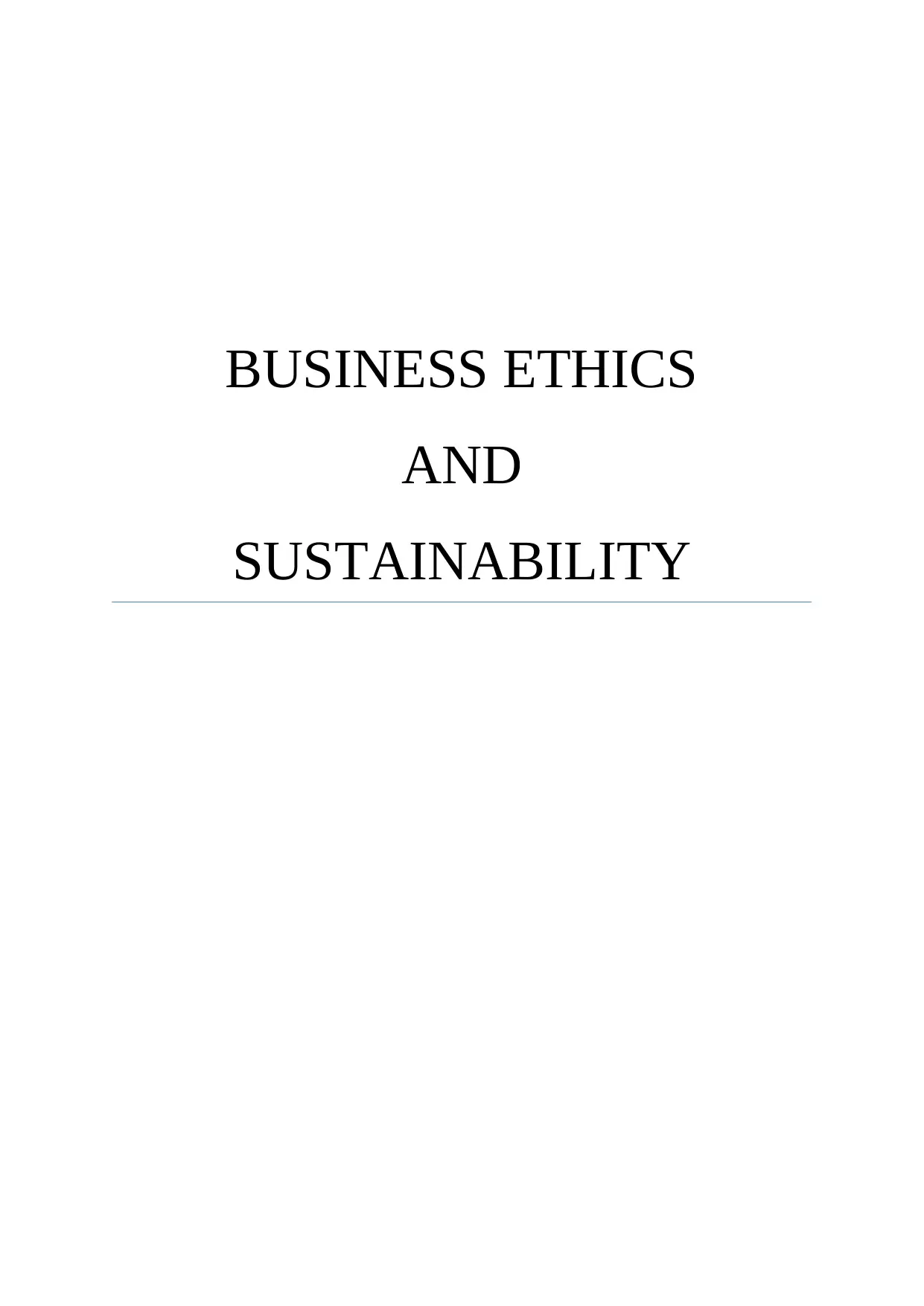
BUSINESS ETHICS
AND
SUSTAINABILITY
AND
SUSTAINABILITY
Paraphrase This Document
Need a fresh take? Get an instant paraphrase of this document with our AI Paraphraser
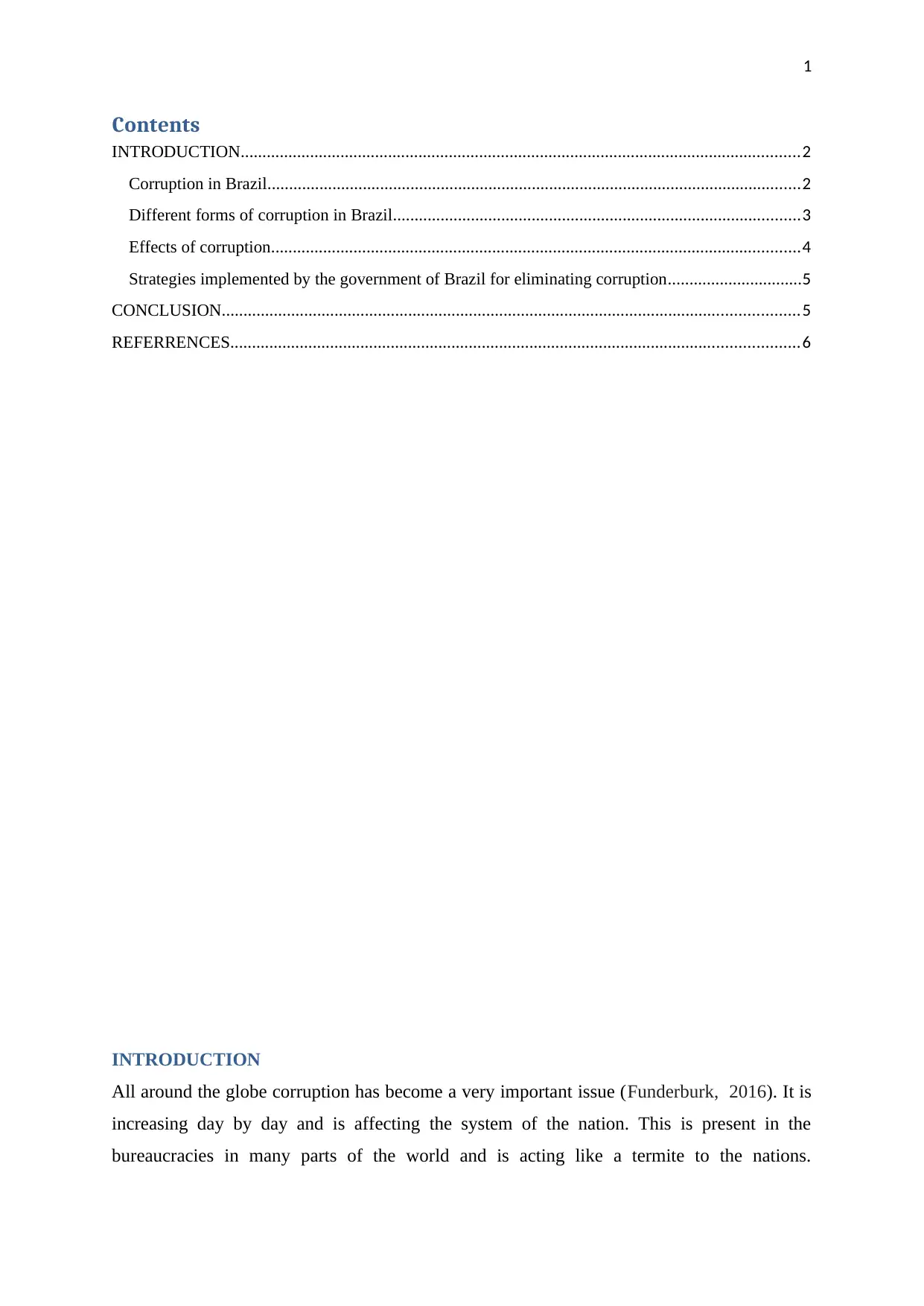
1
Contents
INTRODUCTION.................................................................................................................................2
Corruption in Brazil...........................................................................................................................2
Different forms of corruption in Brazil..............................................................................................3
Effects of corruption..........................................................................................................................4
Strategies implemented by the government of Brazil for eliminating corruption...............................5
CONCLUSION.....................................................................................................................................5
REFERRENCES...................................................................................................................................6
INTRODUCTION
All around the globe corruption has become a very important issue (Funderburk, 2016). It is
increasing day by day and is affecting the system of the nation. This is present in the
bureaucracies in many parts of the world and is acting like a termite to the nations.
Contents
INTRODUCTION.................................................................................................................................2
Corruption in Brazil...........................................................................................................................2
Different forms of corruption in Brazil..............................................................................................3
Effects of corruption..........................................................................................................................4
Strategies implemented by the government of Brazil for eliminating corruption...............................5
CONCLUSION.....................................................................................................................................5
REFERRENCES...................................................................................................................................6
INTRODUCTION
All around the globe corruption has become a very important issue (Funderburk, 2016). It is
increasing day by day and is affecting the system of the nation. This is present in the
bureaucracies in many parts of the world and is acting like a termite to the nations.
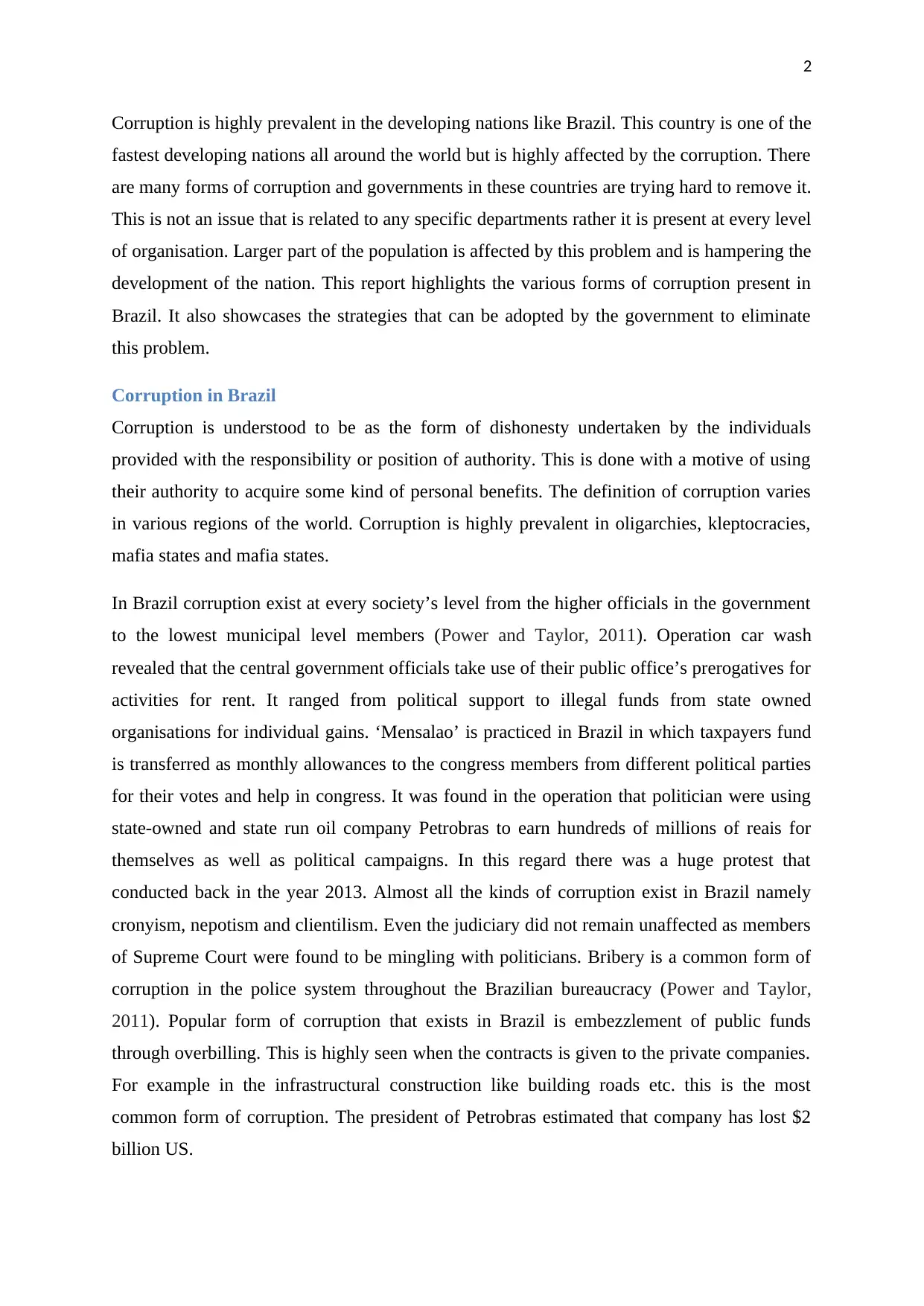
2
Corruption is highly prevalent in the developing nations like Brazil. This country is one of the
fastest developing nations all around the world but is highly affected by the corruption. There
are many forms of corruption and governments in these countries are trying hard to remove it.
This is not an issue that is related to any specific departments rather it is present at every level
of organisation. Larger part of the population is affected by this problem and is hampering the
development of the nation. This report highlights the various forms of corruption present in
Brazil. It also showcases the strategies that can be adopted by the government to eliminate
this problem.
Corruption in Brazil
Corruption is understood to be as the form of dishonesty undertaken by the individuals
provided with the responsibility or position of authority. This is done with a motive of using
their authority to acquire some kind of personal benefits. The definition of corruption varies
in various regions of the world. Corruption is highly prevalent in oligarchies, kleptocracies,
mafia states and mafia states.
In Brazil corruption exist at every society’s level from the higher officials in the government
to the lowest municipal level members (Power and Taylor, 2011). Operation car wash
revealed that the central government officials take use of their public office’s prerogatives for
activities for rent. It ranged from political support to illegal funds from state owned
organisations for individual gains. ‘Mensalao’ is practiced in Brazil in which taxpayers fund
is transferred as monthly allowances to the congress members from different political parties
for their votes and help in congress. It was found in the operation that politician were using
state-owned and state run oil company Petrobras to earn hundreds of millions of reais for
themselves as well as political campaigns. In this regard there was a huge protest that
conducted back in the year 2013. Almost all the kinds of corruption exist in Brazil namely
cronyism, nepotism and clientilism. Even the judiciary did not remain unaffected as members
of Supreme Court were found to be mingling with politicians. Bribery is a common form of
corruption in the police system throughout the Brazilian bureaucracy (Power and Taylor,
2011). Popular form of corruption that exists in Brazil is embezzlement of public funds
through overbilling. This is highly seen when the contracts is given to the private companies.
For example in the infrastructural construction like building roads etc. this is the most
common form of corruption. The president of Petrobras estimated that company has lost $2
billion US.
Corruption is highly prevalent in the developing nations like Brazil. This country is one of the
fastest developing nations all around the world but is highly affected by the corruption. There
are many forms of corruption and governments in these countries are trying hard to remove it.
This is not an issue that is related to any specific departments rather it is present at every level
of organisation. Larger part of the population is affected by this problem and is hampering the
development of the nation. This report highlights the various forms of corruption present in
Brazil. It also showcases the strategies that can be adopted by the government to eliminate
this problem.
Corruption in Brazil
Corruption is understood to be as the form of dishonesty undertaken by the individuals
provided with the responsibility or position of authority. This is done with a motive of using
their authority to acquire some kind of personal benefits. The definition of corruption varies
in various regions of the world. Corruption is highly prevalent in oligarchies, kleptocracies,
mafia states and mafia states.
In Brazil corruption exist at every society’s level from the higher officials in the government
to the lowest municipal level members (Power and Taylor, 2011). Operation car wash
revealed that the central government officials take use of their public office’s prerogatives for
activities for rent. It ranged from political support to illegal funds from state owned
organisations for individual gains. ‘Mensalao’ is practiced in Brazil in which taxpayers fund
is transferred as monthly allowances to the congress members from different political parties
for their votes and help in congress. It was found in the operation that politician were using
state-owned and state run oil company Petrobras to earn hundreds of millions of reais for
themselves as well as political campaigns. In this regard there was a huge protest that
conducted back in the year 2013. Almost all the kinds of corruption exist in Brazil namely
cronyism, nepotism and clientilism. Even the judiciary did not remain unaffected as members
of Supreme Court were found to be mingling with politicians. Bribery is a common form of
corruption in the police system throughout the Brazilian bureaucracy (Power and Taylor,
2011). Popular form of corruption that exists in Brazil is embezzlement of public funds
through overbilling. This is highly seen when the contracts is given to the private companies.
For example in the infrastructural construction like building roads etc. this is the most
common form of corruption. The president of Petrobras estimated that company has lost $2
billion US.
⊘ This is a preview!⊘
Do you want full access?
Subscribe today to unlock all pages.

Trusted by 1+ million students worldwide
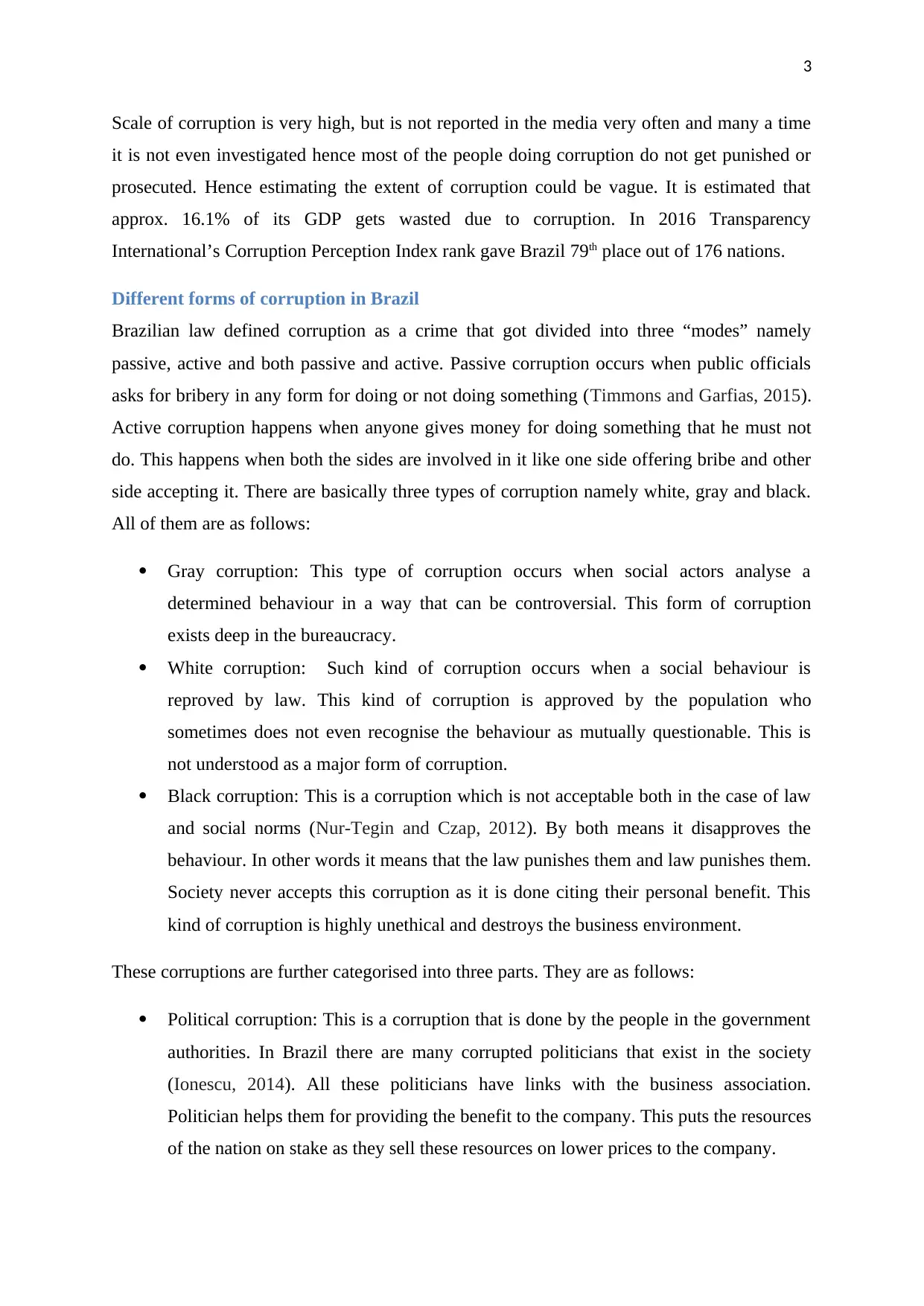
3
Scale of corruption is very high, but is not reported in the media very often and many a time
it is not even investigated hence most of the people doing corruption do not get punished or
prosecuted. Hence estimating the extent of corruption could be vague. It is estimated that
approx. 16.1% of its GDP gets wasted due to corruption. In 2016 Transparency
International’s Corruption Perception Index rank gave Brazil 79th place out of 176 nations.
Different forms of corruption in Brazil
Brazilian law defined corruption as a crime that got divided into three “modes” namely
passive, active and both passive and active. Passive corruption occurs when public officials
asks for bribery in any form for doing or not doing something (Timmons and Garfias, 2015).
Active corruption happens when anyone gives money for doing something that he must not
do. This happens when both the sides are involved in it like one side offering bribe and other
side accepting it. There are basically three types of corruption namely white, gray and black.
All of them are as follows:
Gray corruption: This type of corruption occurs when social actors analyse a
determined behaviour in a way that can be controversial. This form of corruption
exists deep in the bureaucracy.
White corruption: Such kind of corruption occurs when a social behaviour is
reproved by law. This kind of corruption is approved by the population who
sometimes does not even recognise the behaviour as mutually questionable. This is
not understood as a major form of corruption.
Black corruption: This is a corruption which is not acceptable both in the case of law
and social norms (Nur-Tegin and Czap, 2012). By both means it disapproves the
behaviour. In other words it means that the law punishes them and law punishes them.
Society never accepts this corruption as it is done citing their personal benefit. This
kind of corruption is highly unethical and destroys the business environment.
These corruptions are further categorised into three parts. They are as follows:
Political corruption: This is a corruption that is done by the people in the government
authorities. In Brazil there are many corrupted politicians that exist in the society
(Ionescu, 2014). All these politicians have links with the business association.
Politician helps them for providing the benefit to the company. This puts the resources
of the nation on stake as they sell these resources on lower prices to the company.
Scale of corruption is very high, but is not reported in the media very often and many a time
it is not even investigated hence most of the people doing corruption do not get punished or
prosecuted. Hence estimating the extent of corruption could be vague. It is estimated that
approx. 16.1% of its GDP gets wasted due to corruption. In 2016 Transparency
International’s Corruption Perception Index rank gave Brazil 79th place out of 176 nations.
Different forms of corruption in Brazil
Brazilian law defined corruption as a crime that got divided into three “modes” namely
passive, active and both passive and active. Passive corruption occurs when public officials
asks for bribery in any form for doing or not doing something (Timmons and Garfias, 2015).
Active corruption happens when anyone gives money for doing something that he must not
do. This happens when both the sides are involved in it like one side offering bribe and other
side accepting it. There are basically three types of corruption namely white, gray and black.
All of them are as follows:
Gray corruption: This type of corruption occurs when social actors analyse a
determined behaviour in a way that can be controversial. This form of corruption
exists deep in the bureaucracy.
White corruption: Such kind of corruption occurs when a social behaviour is
reproved by law. This kind of corruption is approved by the population who
sometimes does not even recognise the behaviour as mutually questionable. This is
not understood as a major form of corruption.
Black corruption: This is a corruption which is not acceptable both in the case of law
and social norms (Nur-Tegin and Czap, 2012). By both means it disapproves the
behaviour. In other words it means that the law punishes them and law punishes them.
Society never accepts this corruption as it is done citing their personal benefit. This
kind of corruption is highly unethical and destroys the business environment.
These corruptions are further categorised into three parts. They are as follows:
Political corruption: This is a corruption that is done by the people in the government
authorities. In Brazil there are many corrupted politicians that exist in the society
(Ionescu, 2014). All these politicians have links with the business association.
Politician helps them for providing the benefit to the company. This puts the resources
of the nation on stake as they sell these resources on lower prices to the company.
Paraphrase This Document
Need a fresh take? Get an instant paraphrase of this document with our AI Paraphraser
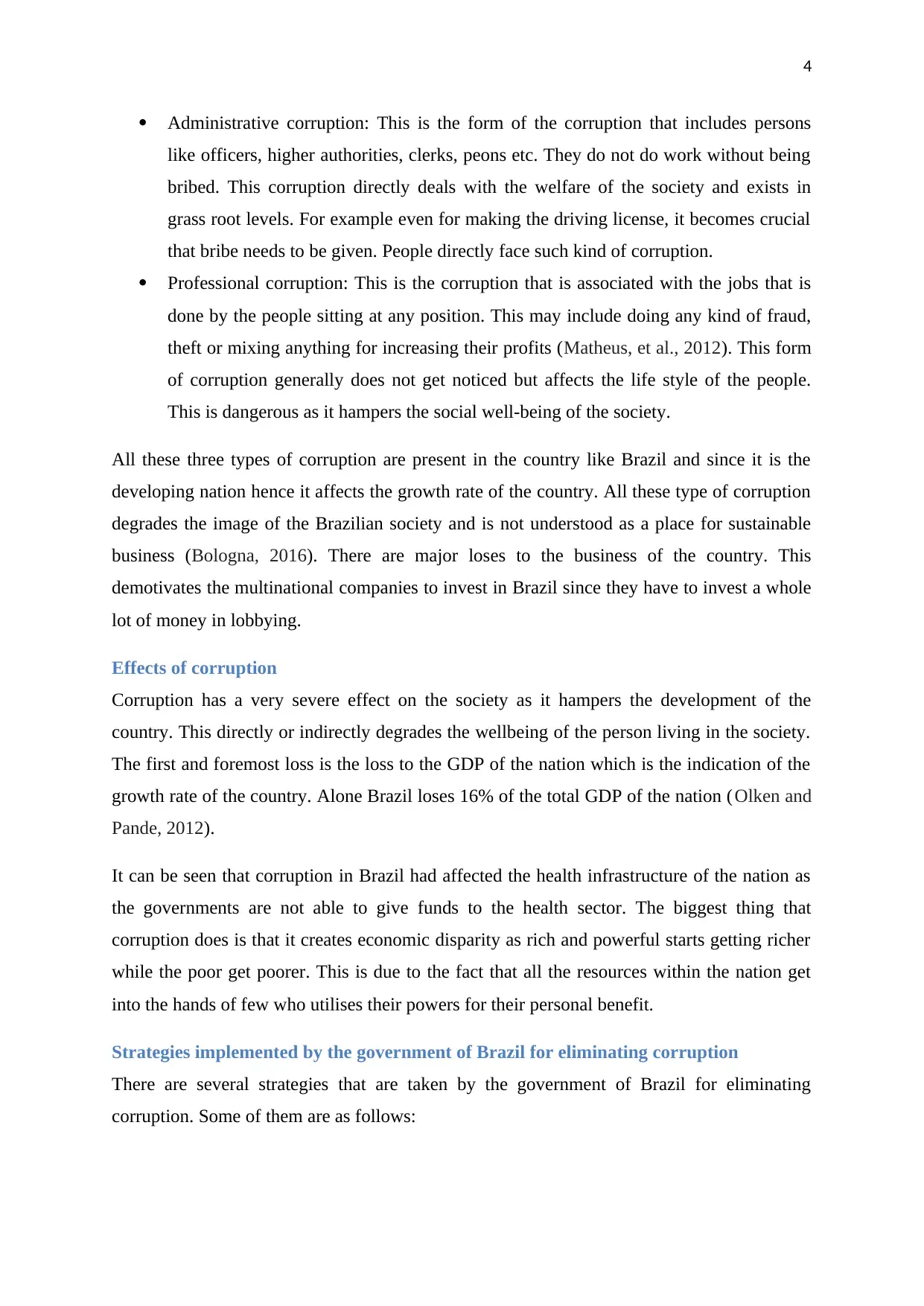
4
Administrative corruption: This is the form of the corruption that includes persons
like officers, higher authorities, clerks, peons etc. They do not do work without being
bribed. This corruption directly deals with the welfare of the society and exists in
grass root levels. For example even for making the driving license, it becomes crucial
that bribe needs to be given. People directly face such kind of corruption.
Professional corruption: This is the corruption that is associated with the jobs that is
done by the people sitting at any position. This may include doing any kind of fraud,
theft or mixing anything for increasing their profits (Matheus, et al., 2012). This form
of corruption generally does not get noticed but affects the life style of the people.
This is dangerous as it hampers the social well-being of the society.
All these three types of corruption are present in the country like Brazil and since it is the
developing nation hence it affects the growth rate of the country. All these type of corruption
degrades the image of the Brazilian society and is not understood as a place for sustainable
business (Bologna, 2016). There are major loses to the business of the country. This
demotivates the multinational companies to invest in Brazil since they have to invest a whole
lot of money in lobbying.
Effects of corruption
Corruption has a very severe effect on the society as it hampers the development of the
country. This directly or indirectly degrades the wellbeing of the person living in the society.
The first and foremost loss is the loss to the GDP of the nation which is the indication of the
growth rate of the country. Alone Brazil loses 16% of the total GDP of the nation (Olken and
Pande, 2012).
It can be seen that corruption in Brazil had affected the health infrastructure of the nation as
the governments are not able to give funds to the health sector. The biggest thing that
corruption does is that it creates economic disparity as rich and powerful starts getting richer
while the poor get poorer. This is due to the fact that all the resources within the nation get
into the hands of few who utilises their powers for their personal benefit.
Strategies implemented by the government of Brazil for eliminating corruption
There are several strategies that are taken by the government of Brazil for eliminating
corruption. Some of them are as follows:
Administrative corruption: This is the form of the corruption that includes persons
like officers, higher authorities, clerks, peons etc. They do not do work without being
bribed. This corruption directly deals with the welfare of the society and exists in
grass root levels. For example even for making the driving license, it becomes crucial
that bribe needs to be given. People directly face such kind of corruption.
Professional corruption: This is the corruption that is associated with the jobs that is
done by the people sitting at any position. This may include doing any kind of fraud,
theft or mixing anything for increasing their profits (Matheus, et al., 2012). This form
of corruption generally does not get noticed but affects the life style of the people.
This is dangerous as it hampers the social well-being of the society.
All these three types of corruption are present in the country like Brazil and since it is the
developing nation hence it affects the growth rate of the country. All these type of corruption
degrades the image of the Brazilian society and is not understood as a place for sustainable
business (Bologna, 2016). There are major loses to the business of the country. This
demotivates the multinational companies to invest in Brazil since they have to invest a whole
lot of money in lobbying.
Effects of corruption
Corruption has a very severe effect on the society as it hampers the development of the
country. This directly or indirectly degrades the wellbeing of the person living in the society.
The first and foremost loss is the loss to the GDP of the nation which is the indication of the
growth rate of the country. Alone Brazil loses 16% of the total GDP of the nation (Olken and
Pande, 2012).
It can be seen that corruption in Brazil had affected the health infrastructure of the nation as
the governments are not able to give funds to the health sector. The biggest thing that
corruption does is that it creates economic disparity as rich and powerful starts getting richer
while the poor get poorer. This is due to the fact that all the resources within the nation get
into the hands of few who utilises their powers for their personal benefit.
Strategies implemented by the government of Brazil for eliminating corruption
There are several strategies that are taken by the government of Brazil for eliminating
corruption. Some of them are as follows:
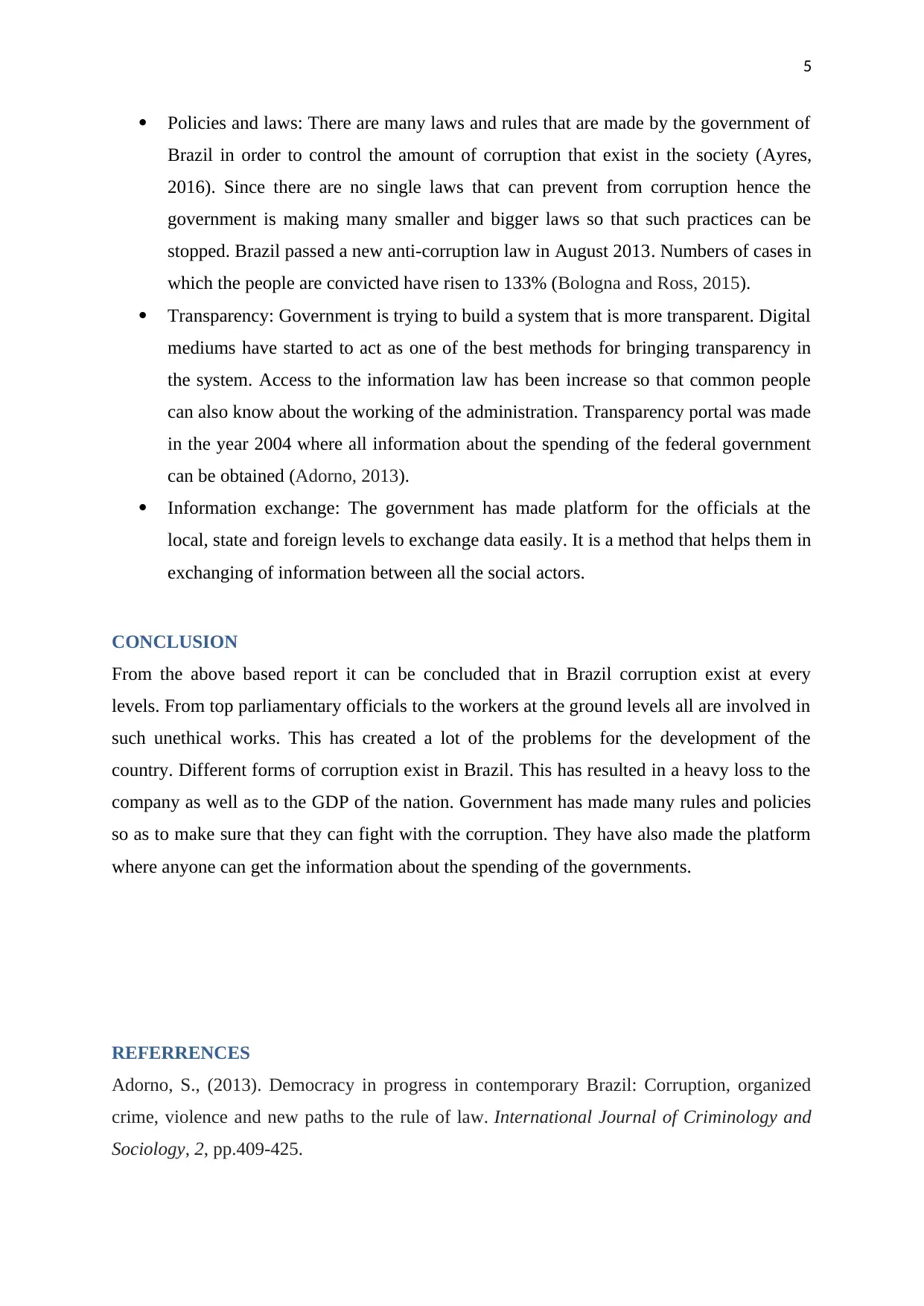
5
Policies and laws: There are many laws and rules that are made by the government of
Brazil in order to control the amount of corruption that exist in the society (Ayres,
2016). Since there are no single laws that can prevent from corruption hence the
government is making many smaller and bigger laws so that such practices can be
stopped. Brazil passed a new anti-corruption law in August 2013. Numbers of cases in
which the people are convicted have risen to 133% (Bologna and Ross, 2015).
Transparency: Government is trying to build a system that is more transparent. Digital
mediums have started to act as one of the best methods for bringing transparency in
the system. Access to the information law has been increase so that common people
can also know about the working of the administration. Transparency portal was made
in the year 2004 where all information about the spending of the federal government
can be obtained (Adorno, 2013).
Information exchange: The government has made platform for the officials at the
local, state and foreign levels to exchange data easily. It is a method that helps them in
exchanging of information between all the social actors.
CONCLUSION
From the above based report it can be concluded that in Brazil corruption exist at every
levels. From top parliamentary officials to the workers at the ground levels all are involved in
such unethical works. This has created a lot of the problems for the development of the
country. Different forms of corruption exist in Brazil. This has resulted in a heavy loss to the
company as well as to the GDP of the nation. Government has made many rules and policies
so as to make sure that they can fight with the corruption. They have also made the platform
where anyone can get the information about the spending of the governments.
REFERRENCES
Adorno, S., (2013). Democracy in progress in contemporary Brazil: Corruption, organized
crime, violence and new paths to the rule of law. International Journal of Criminology and
Sociology, 2, pp.409-425.
Policies and laws: There are many laws and rules that are made by the government of
Brazil in order to control the amount of corruption that exist in the society (Ayres,
2016). Since there are no single laws that can prevent from corruption hence the
government is making many smaller and bigger laws so that such practices can be
stopped. Brazil passed a new anti-corruption law in August 2013. Numbers of cases in
which the people are convicted have risen to 133% (Bologna and Ross, 2015).
Transparency: Government is trying to build a system that is more transparent. Digital
mediums have started to act as one of the best methods for bringing transparency in
the system. Access to the information law has been increase so that common people
can also know about the working of the administration. Transparency portal was made
in the year 2004 where all information about the spending of the federal government
can be obtained (Adorno, 2013).
Information exchange: The government has made platform for the officials at the
local, state and foreign levels to exchange data easily. It is a method that helps them in
exchanging of information between all the social actors.
CONCLUSION
From the above based report it can be concluded that in Brazil corruption exist at every
levels. From top parliamentary officials to the workers at the ground levels all are involved in
such unethical works. This has created a lot of the problems for the development of the
country. Different forms of corruption exist in Brazil. This has resulted in a heavy loss to the
company as well as to the GDP of the nation. Government has made many rules and policies
so as to make sure that they can fight with the corruption. They have also made the platform
where anyone can get the information about the spending of the governments.
REFERRENCES
Adorno, S., (2013). Democracy in progress in contemporary Brazil: Corruption, organized
crime, violence and new paths to the rule of law. International Journal of Criminology and
Sociology, 2, pp.409-425.
⊘ This is a preview!⊘
Do you want full access?
Subscribe today to unlock all pages.

Trusted by 1+ million students worldwide
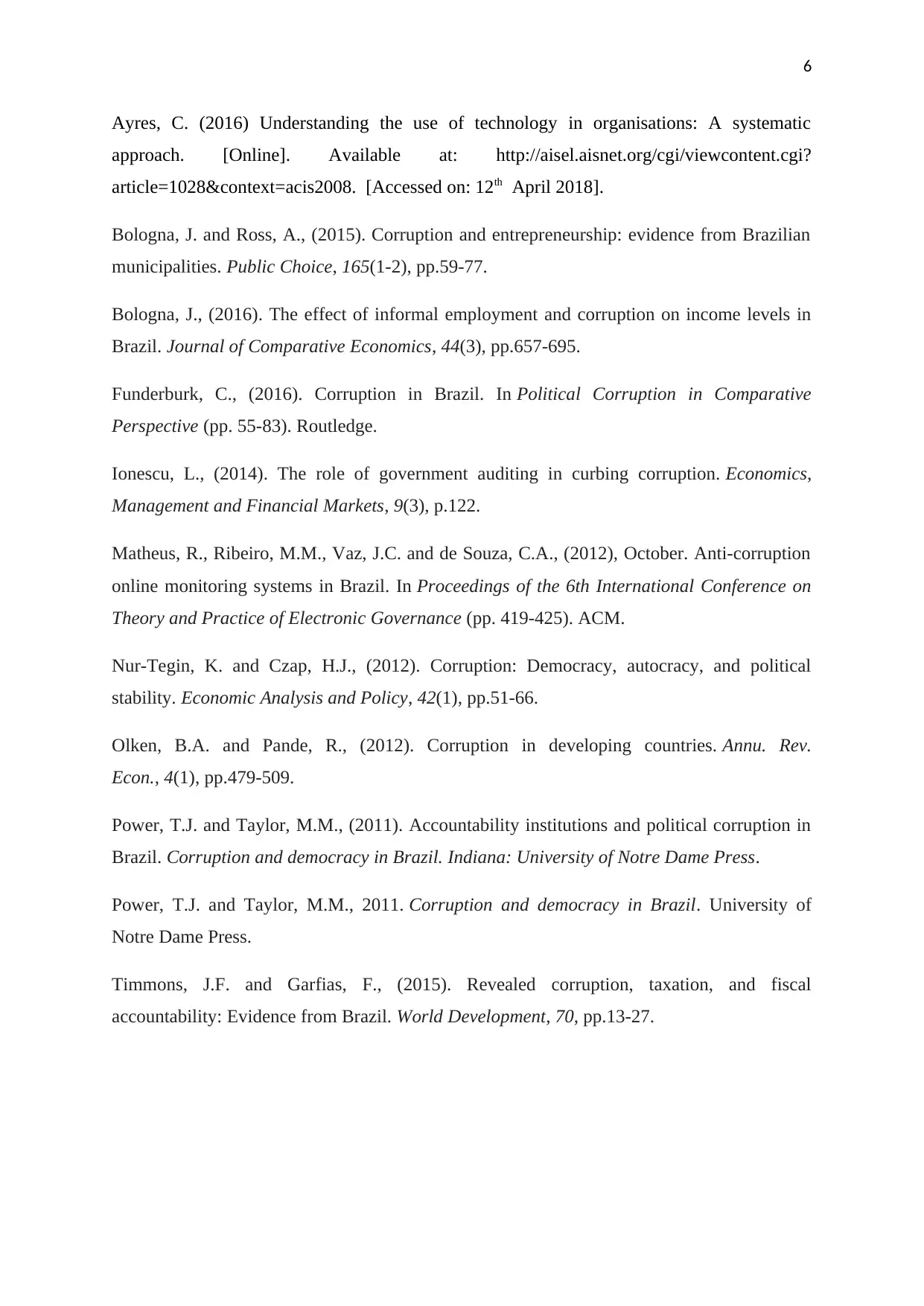
6
Ayres, C. (2016) Understanding the use of technology in organisations: A systematic
approach. [Online]. Available at: http://aisel.aisnet.org/cgi/viewcontent.cgi?
article=1028&context=acis2008. [Accessed on: 12th April 2018].
Bologna, J. and Ross, A., (2015). Corruption and entrepreneurship: evidence from Brazilian
municipalities. Public Choice, 165(1-2), pp.59-77.
Bologna, J., (2016). The effect of informal employment and corruption on income levels in
Brazil. Journal of Comparative Economics, 44(3), pp.657-695.
Funderburk, C., (2016). Corruption in Brazil. In Political Corruption in Comparative
Perspective (pp. 55-83). Routledge.
Ionescu, L., (2014). The role of government auditing in curbing corruption. Economics,
Management and Financial Markets, 9(3), p.122.
Matheus, R., Ribeiro, M.M., Vaz, J.C. and de Souza, C.A., (2012), October. Anti-corruption
online monitoring systems in Brazil. In Proceedings of the 6th International Conference on
Theory and Practice of Electronic Governance (pp. 419-425). ACM.
Nur-Tegin, K. and Czap, H.J., (2012). Corruption: Democracy, autocracy, and political
stability. Economic Analysis and Policy, 42(1), pp.51-66.
Olken, B.A. and Pande, R., (2012). Corruption in developing countries. Annu. Rev.
Econ., 4(1), pp.479-509.
Power, T.J. and Taylor, M.M., (2011). Accountability institutions and political corruption in
Brazil. Corruption and democracy in Brazil. Indiana: University of Notre Dame Press.
Power, T.J. and Taylor, M.M., 2011. Corruption and democracy in Brazil. University of
Notre Dame Press.
Timmons, J.F. and Garfias, F., (2015). Revealed corruption, taxation, and fiscal
accountability: Evidence from Brazil. World Development, 70, pp.13-27.
Ayres, C. (2016) Understanding the use of technology in organisations: A systematic
approach. [Online]. Available at: http://aisel.aisnet.org/cgi/viewcontent.cgi?
article=1028&context=acis2008. [Accessed on: 12th April 2018].
Bologna, J. and Ross, A., (2015). Corruption and entrepreneurship: evidence from Brazilian
municipalities. Public Choice, 165(1-2), pp.59-77.
Bologna, J., (2016). The effect of informal employment and corruption on income levels in
Brazil. Journal of Comparative Economics, 44(3), pp.657-695.
Funderburk, C., (2016). Corruption in Brazil. In Political Corruption in Comparative
Perspective (pp. 55-83). Routledge.
Ionescu, L., (2014). The role of government auditing in curbing corruption. Economics,
Management and Financial Markets, 9(3), p.122.
Matheus, R., Ribeiro, M.M., Vaz, J.C. and de Souza, C.A., (2012), October. Anti-corruption
online monitoring systems in Brazil. In Proceedings of the 6th International Conference on
Theory and Practice of Electronic Governance (pp. 419-425). ACM.
Nur-Tegin, K. and Czap, H.J., (2012). Corruption: Democracy, autocracy, and political
stability. Economic Analysis and Policy, 42(1), pp.51-66.
Olken, B.A. and Pande, R., (2012). Corruption in developing countries. Annu. Rev.
Econ., 4(1), pp.479-509.
Power, T.J. and Taylor, M.M., (2011). Accountability institutions and political corruption in
Brazil. Corruption and democracy in Brazil. Indiana: University of Notre Dame Press.
Power, T.J. and Taylor, M.M., 2011. Corruption and democracy in Brazil. University of
Notre Dame Press.
Timmons, J.F. and Garfias, F., (2015). Revealed corruption, taxation, and fiscal
accountability: Evidence from Brazil. World Development, 70, pp.13-27.
Paraphrase This Document
Need a fresh take? Get an instant paraphrase of this document with our AI Paraphraser

7
1 out of 8
Related Documents
Your All-in-One AI-Powered Toolkit for Academic Success.
+13062052269
info@desklib.com
Available 24*7 on WhatsApp / Email
![[object Object]](/_next/static/media/star-bottom.7253800d.svg)
Unlock your academic potential
Copyright © 2020–2025 A2Z Services. All Rights Reserved. Developed and managed by ZUCOL.





